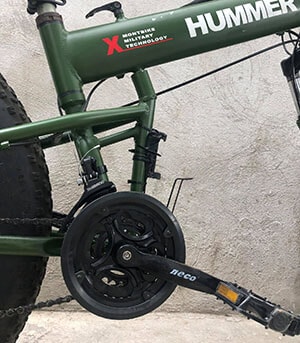I love that video titled “Nun Destroying Pro Cyclist with Vintage Bike.” Riding downhill is fun, isn’t it?
However, it’s crazy to humiliate pro cyclists with a vintage bike. But you can ride at pace when you are on a single-speed fixie. Let me explain.
When you ride a single speed, the gear is fixed. The fixed gear is almost like the highest gear of a multispeed bike.
And, to accelerate the bicycle, you need to shift it to the highest gear.
Anyways, I have described the rear derailleur problem and solution in my previous post.
After that post, many people commented that their front derailleur is also not shifting to the highest gear.
As a result, they can’t accelerate their bike while riding downhill. So, in today’s post, I will discuss front derailleur problems and their solutions.
Why won’t my front derailleur shift to the highest gear?
It can happen because of the wrong alignment of the chain cage or the low shifting cable tension. Let’s dig it out.
1. The cage can’t move enough to shift the chain when the cable tension is too low.
2. The wrong alignment of the chain cage can also create this problem. Too high or too low chain cage can cause chain rubbing or inefficient shifting.
3. It can happen because of too tight or too loose limit screws.
Limit screws prevent the chain from going inward (bottom bracket) or outward (crankarm).
When they are too tight or too loose, the cage can’t travel within the required distance.
| Freaky Tip: When the shifting cable is severely damaged from the inside, it can also cause gears not to shift. it would be better to replace the cable instead of fixing it. |
How to fix the front derailleur?

Well, you need some adjustments to fix the front derailleur.
Keep a few tools ready and do the job.
When the chain cage will be aligned right and the limit screw on the optimum position, all the shifting will be eliminated automatically.
But, you have to do it in the right way. To know what I mean by the right way, read the post to the end.
However, let’s know about the necessary tools for the front derailleur adjustment:
- Repair Stand: To hang the bike so that you can easily rotate the pedal and check everything.
- Screwdriver / Hex wrench: For adjusting the chain cage position and limit screws setting.
| Freaky Tip: A clean and well-lubed chain also played a vital role in efficient shifting power. Follow our Bike Chain Cleaning & Maintenance guide to get a healthy chain. |
How to Adjust Front Derailleur
Now I am gonna discuss the basics of Front derailleur adjustment. Follow the below steps to solve the shifting problem I have described earlier.
If you have more questions about front derailleur adjustment, jump into the FAQ section.
There I have answered some common questions about front derailleurs.
Now, hang your bike on the repair stand to go for the real stuff.
Step-1: Aligning the Derailleur Cage

The position of the derailleur cage is crucial for smooth shifting.
Too high cage position can cause chain fall, where chain rubbing problems occur for a too low position.
However, the chain can also rub when the cage is not parallel to the chainring. For fixing all these problems, follow the below steps.
1. Firstly check the cage position. Is it parallel and just 2-3 mm above the largest chainring? If the answer is no, the alignment is not correct.
Now, take a screwdriver or hex key and loosen the cage holder screw.
2. Secondly, set the cage in the correct position. You can mark the position with a marker if it seems difficult to remember.
3. Finally, tighten the cage holder screw holding the cage in the correct position.
| Note: Different manufacturers offer different types of cages. So, the optimum position can vary a little bit. Just ensure such an alignment from where the chain can’t rub or fall. |
Step-2: Setting up the L Limit Screw
The L limit screw prevents the chain from going too outward (crank arm). By tightening it, you can bring the cage inward.
However, follow the below steps for setting up the L Limit Screw.
1. Firstly, shift the chain to the lowest gear (smallest chainring and largest cog). Then identify the L-screw.
It should be marked as “L” on the front derailleur. If it’s not marked, rotate both limit screws clockwise and observe the cage movement.
For which screw the cage moves inward is the L-screw.
2. Secondly, turn the L-screw clockwise until the cage rubs against the chain.
Rotate the pedal to check if it’s rubbing or not. Immediately after it starts rubbing, stop tightening the L-screw.
3. Thirdly, give one or two turns to the barrel adjuster. Thus the gap between cage and chain will increase.
Then, tighten the L-screw to minimize the gap. Do it until the cage starts rubbing against the chain.
4. Now, rotate the L-screw a quarter turn to eliminate the rubbing. Then re-thread the barrel adjuster.
5. Finally, check if the chain is shifting correctly or not. If there is no shift or slow shift, follow the above step again.
Step-3: Setting up the H Limit Screw
The H limit screw prevents the chain from going too inward (bottom bracket).
By loosening it, you can bring the cage outward. However, follow the below steps for setting up the H Limit Screw.
1. Setting up the H limit screw is almost like setting up the L limit screw. At first, shift the chain to the highest gear (smallest cog and largest chainring).
If the front derailleur won’t shift to the highest gear, go to the next step.
2. Turn the barrel adjuster anticlockwise. If the adjuster comes out of the shift lever, then re-thread the barrel fully.
Now, loosen the cable holder screw and pull out the cable to adjust cable tension. Lastly, retighten the cable holder.
3. After that, loosen the barrel adjuster with a couple of turns. Then, try to shift the chain to the smallest ring.
If it’s not shifting, loosen the H limit screw until there is smooth shifting. Even after it is fixed, turn it anticlockwise once or twice.
4. Finally, tighten the H Limit screw to minimize the gap between the inner cage and the chain.
If there is still a shifting problem, adjust the H Limit with a quarter turn. Rotate anticlockwise for the slow shift and clockwise for chain fall.
Step-4: Indexing Adjustment

Multispeed bikes generally come with 2 types of the crankset, double and triple.
Double crankset offers 2 different shifting positions where triple provides 3 different shifting positions.
However, indexing means the correct alignment of these positions.
Anyways, the shifting cable comes to the front on indexing adjustment. Go step by step to get the index setting done.
1. Firstly, shift the chain to the highest gear (largest chainring and smallest cog). Then turn the barrel adjuster anticlockwise.
Then, push the shift lever slightly and check if there is any movement on the cage.
2. If there is no movement, rotate the adjuster clockwise until the cage move. Again, slowly turn the adjuster until the outward movement is gone. Indexing adjustment is now made.
| Freaky Tip: After you are done with front derailleur adjustment, go for a test ride and check if the derailleur is shifting correctly or not. If it is not shifting correctly, give a quarter turn to the limit screws and barrel adjuster. |
Frequently Asked Questions About Derailleurs
Why my bike chain is still rubbing for the biggest-to-biggest combination?
Even after derailleur adjustment, you can face chain rub against the cage for some specific combination.
For example, the smallest-to-smallest or the biggest-to-biggest. It can happen because the brand of bike you use is not compatible to use these combinations.
Try to use other varieties with the same gear ratio.
Anyways, when you want to force-adjust the derailleur for these combinations, the other gear will start rubbing then.
However, some bikes feature a trim adjustment. You don’t need any separate adjustments.
Just click once, and the derailleur will adjust automatically with slight movement.
Are front derailleurs interchangeable?
Yes! The front derailleur is interchangeable for different chains (7,8,9 or 10 speed).
But there are some compatibility issues to consider. First of all, you have to consider the type of chainring.
Derailleur of double chainring may not suit on the triple crankset. However, adjustment can get a little bit tricky if you interchange the derailleurs.
Should I adjust the front or rear derailleur first?
As the front derailleur needs subtle adjustment, it’s better to work on it first.
Otherwise, rear derailleur adjustment won’t get right, and you have to readjust it.
However, don’t forget to check the overall adjustment with a test ride. Thus, you can identify subtle problems and solve them with minor adjustments.
Conclusion
It’s too frustrating for me to see my mates leaving me behind on the track. I think you must have the same feeling.
It’s too boring if you can’t ride at pace on downhill tracks. It will be challenging to accelerate your bike when the front derailleur won’t shift to the largest gear.
That’s why you need front derailleur adjustment. Basic fine-tuning can help you to get rid of all shifting problems. And offer you a speedy ride.
However, the process I describe above can help you to adjust the front derailleur. Follow it and enjoy your next downhill ride.
Cheers!
